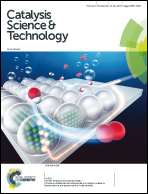Encapsulating nano rods of copper–biphenylamines framework on g-C3N4 photocatalysts for visible-light-driven organic dyes degradation: promoting charge separation efficiency†
Abstract
For the first time we have successfully constructed semi conductive copper–biphenylamines framework hybrid photocatalysts to degrade organic pollutants. Cu complexes sensitized photocatalysts of g-C3N4, i.e. CN-Cu(BN), CN-Cu(PD) and CN-Cu(BA), have been successfully tested for photocatalytic degradation of organic pollutants under visible light illumination, and a significant enhancement in catalytic activity was observed for CN-Cu(BA) in comparison to pristine g-C3N4. The modified material creates a charge separation with the electrons populating the higher CB and the holes the lower VB, thus enhancing the redox reaction power of the charge carriers. CN-Cu (BA) can easily degrade 99% of RhB in 1.5 hours and 60% of phenol in 2 hours. While the degradation efficiency of CN-Cu(BN), CN-Cu(PD) and g-C3N4 is lower than that of CN-Cu(BA). The kobs for CN-Cu(BN) is 0.01985 min−1, 5.2 times higher than that of g-C3N4, and that of CN-Cu(BA) is 0.0292 min−1 which is 7.55 times greater than that of pristine g-C3N4. These degradation outcomes are favourable for developing a modified catalyst in bulk amount and its application. The strong holes can directly degrade RhB and phenol. Promoting the injection of electrons from g-C3N4 into the copper unit as well as strengthening the electronic interactions between the two units enhanced its activity.



 Please wait while we load your content...
Please wait while we load your content...